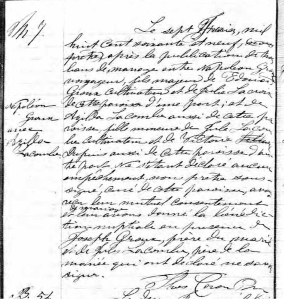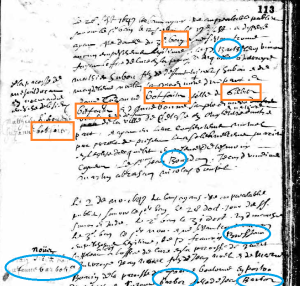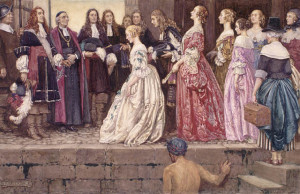Posts Tagged King’s Daughters
#52 Ancestors – No. 36 – Napoleon Groulx (Groux)
Posted by Caroll in French Canadian Genealogy, Genealogy on September 7, 2014
This post is number 36 in the series of the #52 Ancestors in 52 Weeks Challenge where a group of us blog about a different ancestor for each week of the year. To learn more about the 52 Ancestor Challenge visit Amy Johnson’s site at Amy’s website.
Glad to know my five years of French through high school and college still has some use today. Not that I can speak the language anymore. Being able to recognize french words and handwriting styles comes in handy in deciphering French Canadian historical records. It is a necessary skill to have. One of the most useful Quebec vital records are the Drouin church records.
I am a descendent of French ancestors who were settled Quebec in the 1600’s. In addition to my direct line, I have a few collateral lines who married individuals of French ancestry that I also research. I try my best to read the French records to glean information.
My grand aunt, Opal Anderson, daughter of Ernest Anderson and Minnie White; married Norman Joseph Groulx. Norman is the grandson of Napoleon Groux and Azilda (Exilda) Lacombe. Napoleon and Azilda were married in Ripon, Quebec, Canada, in 1869. The marriage was witnessed by Joseph Groux and Jule Lacombe.
I am not sure why the letter “l” was added to the name. It could be to help the pronunciation in English. My family pronounced the name as “Grew”. The marriage date is written in a flourish scroll, and I cannot clearly read the month. The date in French is; Le sept Janvier or Fevrier, [mil] huit cent soixante et neuf. Translated to 7 January or February 1869.
I have not been able to find a surname meaning for Groux. There is a church, Saint Groux, in France. Google maps displayed a couple of streets name Les Groux in several French cities. Since it is a collateral line, further research is usually when I get blocked by a wall and need a distraction.
Photo Source Information:
#52 Ancestors – No. 15 – Suzanne Botfaite
Posted by Caroll in French Canadian Genealogy, Genealogy on April 13, 2014
This post is number 15 in the series of the 52 Ancestors in 52 Weeks Challenge where a group of us blog about a different ancestor for each week of the year. To learn more about the 52 Ancestor Challenge visit Amy’s website.
Is it Botfaite or Gotfaite, that is the question?
There are several printed transcribed records of the immigrants and settlers of New France (Quebec) as well as the handwritten records of of the church. The handwritten records are in French. Specifically I am looking at the Drouin Collection. The collection is the work of Joseph Drouin, founder of the Drouin Genealogical Institute. The collection contains French-Canadian and English historical records from 1621-1967. The institute microfilmed the Quebec parish records back in the 19060’s.
My 10th great grandmother is Suzanne Botfaite. She was born in England about 1630 and died in Quebec in 1694. She is the daughter of Gilbert Botfaite and Anne Bonne. I have not been able to find the family in England. They have French names and good have easily moved back and forth from England to France before making the move to find a new life in Quebec.
The printed records stated various spellings for the Botfaite name. They include Betfer, Bedfer, Bedford, Bottefer, and a few others. There is another microfilmed capture of a Suzanne Bottefair that I am unable to decipher the flourish handwriting.
I find the microfilmed Drouin record interesting. In reviewing the record that last name appears to be spelled with a “G” not the letter “B”. I have looked at words starting with a capital “B” or “G” in this particular register and see a distinct pattern. The lower case “b” and “g” look similar. It most cases the “B” has a flourish or stroke on the left stem of the letter. I can see why a transcriber would think the first letter is a “B”. The more I look at the handwriting, the more I think the last name started with a “G” and may be Gotfaite instead. Now I just need to confirm my hypothesis.
Below is the entry of Suzanne’s 1649 marriage record to Mathieu Hubou at the Notre Dame parish in Montreal, Quebec. I highlighted words with the letter “G” in red. The blue circles are the letter “B”. Suzanne’s father, Gilbert is in one of the red boxes. The “G” in his name is written is similar to the first letter in Gotfaite. So, what do you think? Is it a “G” or “B”?
Source Information:
#52Ancestors – The King’s Daughters Marguerite Cardillion #1
I am taking up the challenge leveled by Amy Johnson at No Story Too Small. The challenge is to write one blog post each week on one of your ancestors for 2014. The challenge is a tool to write consistently, which is what I don’t do. I write one long blog a week and should write a few times a week.
I chose my 8th great grandmother, Marguerite Cardillion. Marguerite was born in St-Gervais, Paris, Ile de France, France in 1651 (some records show 1641). In 1665 she left France for the Canada sponsored by the French Government as a Les Filles de Roi (King’s Daughters). France was desperately trying to increase population of New France in the 1660’s to preserve their threshold in the New World.
The were many men in Quebec and very few women. Women were wanted to marry and bring forth many children to the new colony. The Crown offered a King’s dowry to women who willing went to the new world. Girls or young women who were either orphaned or without means to offer a dowry for a suitable marriage were eschewed in 1600’s France. Either condemned to women’s pauper prisons, convents, or worse yet the streets, some felt their only escape was a chance in an unknown new world. About 800 women took up the endeavor and traveled across the Atlantic to Quebec to become wives of soldiers and settlers.
The crossing took two months in the hold of a stinking ship. To survive that voyage, a person needed to be of hardy stock. Though the men wanted good looking women, they needed stocky women who could work a new farm and bear many, many children. Marguerite most likely married within six months of arriving. The women/girls did have time to get to know the men that were courting them before entering a contract of marriage. There was very little hanky-panky back then. Everything was kept prim and proper by the Church, nuns and society itself.
I chose Marguerite for this post because she took a chance leaving France where she faced hardship as an orphan with no way of supporting herself. Going to a strange land where she might not even survive the crossing, willing to contract a marriage to a man she barely knew and knowing there was no return to France if she changed her mind.
She fulfilled the Crown’s goal of populating the French Colony. That 15 year old girl is the 8th great grandmother to hundreds of descendents in Canada and the United States. n the U.S.
Photo credit: http://www.migrations.fr/700fillesroy.htm



Recent Comments